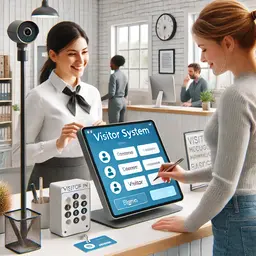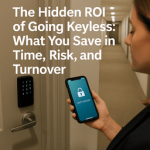
Ensuring the safety and security of students, staff, and faculty is a top priority for any educational institution. Schools, colleges, and universities often deal with a constant influx of visitors, from parents and contractors to vendors and community members. Managing and monitoring this traffic is critical to maintaining a safe and organized campus. A robust visitor management system (VMS) provides the tools to streamline this process while enhancing security and accountability. In this article, we’ll explore the importance of visitor management systems in educational facilities, their key features, and how they contribute to a safer learning environment.
What is a Visitor Management System (VMS)?
A visitor management system is a digital or manual tool designed to track, record, and manage the entry and movement of visitors within a facility. In the context of educational institutions, a VMS ensures that all visitors are identified, authorized, and accounted for while on campus. Modern systems often integrate with other security tools, such as access control systems, surveillance cameras, and databases, to provide a seamless and secure experience.
Why is a Visitor Management System Essential in Schools?
- Enhancing Campus Security
A VMS helps prevent unauthorized individuals from gaining access to school premises. By screening and documenting every visitor, these systems ensure that only approved individuals can enter sensitive areas. Features such as ID scanning and visitor badges create an additional layer of security. - Safeguarding Students and Staff
The safety of students and staff is paramount. A visitor management system can flag individuals who may pose a risk, such as those on a watchlist or with restricted access. This proactive approach minimizes potential threats and fosters a secure environment. - Streamlining the Check-In Process
Traditional manual logbooks can be slow, inefficient, and prone to errors. A digital VMS speeds up the check-in process, reducing congestion at entry points and improving the visitor experience. Automated systems also ensure accurate records without the risk of lost or illegible data. - Accountability and Record-Keeping
Keeping track of who is on campus at any given time is critical for accountability, especially in emergencies. A VMS provides real-time data on visitor activity and generates detailed reports for audits or investigations. - Regulatory Compliance
Many educational institutions are required to comply with safety and privacy regulations. A VMS helps schools meet these standards by securely storing visitor data and ensuring proper documentation of access permissions. - Building Trust with Parents and the Community
A well-implemented visitor management system reassures parents and the community that the school prioritizes the safety of its students. Transparency and efficiency in visitor handling build trust and credibility.
Key Features of a Good Visitor Management System for Schools
- ID Verification and Background Checks
Advanced VMS solutions can scan government-issued IDs, verify visitor identities, and conduct instant background checks to ensure that visitors are safe to enter the campus. - Pre-Registration
Allowing visitors to pre-register online speeds up the check-in process. This feature is particularly useful for scheduled parent-teacher conferences, vendor visits, or school events. - Digital Visitor Badges
Digital or printed visitor badges with names, photos, and time-stamped entry details improve visibility and help staff quickly identify visitors. - Integration with Access Control Systems
A VMS integrated with access control can limit visitor movement to specific areas, such as the front office or auditorium, ensuring they do not wander into restricted zones. - Emergency Alerts and Notifications
In emergencies, a VMS can instantly alert administrators, security personnel, and first responders about who is currently on campus, aiding in evacuation or lockdown procedures. - Visitor Logs and Reporting
Detailed logs of visitor activity, including entry and exit times, purpose of visit, and areas accessed, help schools maintain accurate records and identify patterns or concerns. - Customizable Workflows
A good VMS allows customization to suit the needs of different schools, such as different check-in requirements for parents, contractors, or volunteers.
Benefits of Implementing a Visitor Management System in Educational Facilities
- Increased Safety and Security
By monitoring and controlling visitor access, a VMS significantly reduces the risk of unauthorized entry and enhances overall campus security. - Improved Operational Efficiency
Digital systems automate the check-in process, saving time for administrative staff and ensuring a smoother experience for visitors. - Transparency and Accountability
Real-time visitor tracking ensures transparency and provides an audit trail for any incidents or concerns. - Better Emergency Preparedness
Knowing exactly who is on campus during emergencies allows for more efficient evacuations and faster response times. - Strengthened Relationships with Stakeholders
Parents, staff, and community members feel reassured knowing that the institution has robust measures in place to ensure safety and security.
Challenges in Implementing a Visitor Management System
- Initial Costs
Investing in a modern VMS may require significant upfront costs for hardware, software, and training. However, the long-term benefits often outweigh these expenses. - Staff Training
To maximize the system’s potential, staff must be trained to operate and manage the VMS effectively. Regular training and updates are essential. - Privacy Concerns
Collecting and storing visitor data must comply with privacy laws and regulations. Schools must ensure that their VMS has robust data protection measures in place. - Integration with Existing Systems
Integrating a VMS with legacy systems, such as older access control or surveillance systems, can be complex and may require technical expertise.
Best Practices for Implementing a Visitor Management System
- Conduct a Security Assessment
Evaluate the school’s needs and vulnerabilities to determine the most suitable VMS solution. - Choose a Scalable System
Select a VMS that can grow with the institution, accommodating increasing visitor numbers and evolving security requirements. - Integrate with Existing Security Measures
Ensure the VMS seamlessly integrates with other security systems, such as access control and surveillance cameras. - Educate Staff and Visitors
Train staff to use the system effectively and educate visitors about the check-in process to ensure compliance and smooth operations. - Regularly Review and Update the System
Periodically evaluate the system’s performance and update it to address new security challenges or improve efficiency.
The Future of Visitor Management in Education
As technology evolves, visitor management systems are becoming smarter and more efficient. Emerging trends include:
- AI-Powered Visitor Screening
Artificial intelligence can analyze visitor data to detect potential risks or anomalies in real time. - Cloud-Based Solutions
Cloud-based VMS platforms offer remote management, scalability, and enhanced data security. - Touchless Check-In
Touchless solutions, using QR codes or facial recognition, enhance hygiene and speed up the check-in process. - Mobile Accessibility
Mobile apps allow administrators to monitor visitor activity and receive alerts from anywhere, ensuring continuous oversight.
Conclusion
A robust visitor management system is an indispensable tool for educational facilities, ensuring safety, accountability, and operational efficiency. By controlling access, tracking visitors, and integrating with other security measures, VMS solutions help create a secure and welcoming environment for students, staff, and visitors alike.
Ready to upgrade your school’s visitor management system? Contact us today to learn more about customized solutions for your educational facility.


